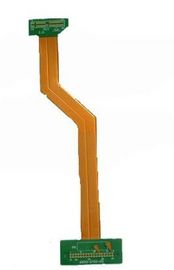FR4 / polyimide rigid flex pcb display board pcb 1 oz legend black or custom
Quick Details
|
Place of Origin: |
China (Mainland) |
Brand Name: |
OEM |
Model Number: |
053 |
|
Base Material: |
FR4/polyimide |
Copper Thickness: |
1oz,1oz or customized |
Board Thickness: |
1.0mm,1.6mm or customized |
|
Min. Hole Size: |
0.15mm |
Min. Line Width: |
0.1mm |
Min. Line Spacing: |
0.1mm |
|
Surface Finishing: |
tin/gold |
solder mask color: |
white or customized |
legend color: |
black or customized |
|
surface treatment: |
variable according to your product
|
substrate: |
FR4 or other |
Specifications
rigid flex pcb display board pcb
1.factory price,fast delivery
2.parts purchase and assembly
3.paypal,L/C
4.ISO,UL,SGS
Testing Procedures For PCB Board:
A) Visual Inspection
B) Flying probe
C) Bed of nails
D) Impedance control
E) Solder-ability detection
F) Digital metallograghic microscope
G) AOI (Automated Optical Inspection)
Detailed Terms for PCB Manufacturing
Technical requirement for pcb assembly:
a) Professional Surface-mounting and Through-hole soldering Technology
b) Various sizes like 1206,0805,0603 components SMT technology
c) ICT(In Circuit Test),FCT(Functional Circuit Test) technology.
d) PCB Assembly With UL,CE,FCC,Rohs Approval
e) Nitrogen gas reflow soldering technology for SMT.
f) High Standard SMT&Solder Assembly Line
g) High density interconnected board placement technology capacity.
Delivery Time for your PCBA project
1) PCB production time: 3-4 days for samples/ within 7 days for mass production
2) Component purchase: within 1 week if all your parts are in stock locally.
If some parts are imported and IC programmed, time takes longer.
3) PCB Assembly: within 1 week if everything is ready,such as stencil and components.
Accidentally #2 and #3 can be processed at the same time.
4) After assembly, if you offer test method, we’ll quote and measure the test time for every piece, free for samples.
No matter you’re local trader or electronics manufacturer, foreign trader or manufacturer, only if your target price is reasonable, we’re pleased to serve you in all satisfaction.:)
Quotation Requirement and Time:
Following specifications are needed besides Gerber for quotation:
a) Base material
b) Board thickness:
c) Copper thickness
d) Surface treatment
e) Color of solder mask and silkscreen
f) Quantity
g) Quick turn time



 Your message must be between 20-3,000 characters!
Your message must be between 20-3,000 characters! Please check your E-mail!
Please check your E-mail!  Your message must be between 20-3,000 characters!
Your message must be between 20-3,000 characters! Please check your E-mail!
Please check your E-mail! 



